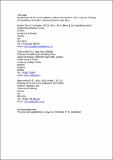Development of the cancer-related loneliness assessment tool : using the findings of a qualitative analysis to generate questionnaire items
Abstract
The aim of this research was to develop a tool to identify and assess the qualities of cancer-related loneliness in adult cancer survivors who have completed treatment. In addition to reporting the development of the tool, we explicate the process of using the findings of a qualitative analysis to generate questionnaire items, as currently little guidance exists on this topic. The findings of our qualitative research exploring the experience of loneliness in adult cancer survivors who had completed treatment, together with the findings of our concept analysis of loneliness, were used to develop an assessment tool for cancer-related loneliness following treatment completion. Cognitive testing was undertaken to assess fidelity of comprehension and feasibility in administration. The Cancer-Related Loneliness Assessment Tool is a ten-item self-report questionnaire capturing the essential elements of cancer-related loneliness following treatment completion. Experts believed the questionnaire to be face-valid and usable in clinical practice, and preliminary cognitive testing indicated that the items generate the information intended and individuals have little trouble completing the tool.Following further development work, the tool could be employed to identify cancer-related loneliness following treatment completion. It could also aid with the development/adaptation and evaluation of person-centred interventions to address such loneliness.
Citation
Cunningham , K B , Kroll , T & Wells , M 2018 , ' Development of the cancer-related loneliness assessment tool : using the findings of a qualitative analysis to generate questionnaire items ' , European Journal of Cancer Care , vol. 27 , no. 2 , e12769 . https://doi.org/10.1111/ecc.12769
Publication
European Journal of Cancer Care
Status
Peer reviewed
ISSN
0961-5423Type
Journal article
Description
The work was supported by a University of Dundee Ph.D. studentship.Collections
Items in the St Andrews Research Repository are protected by copyright, with all rights reserved, unless otherwise indicated.

